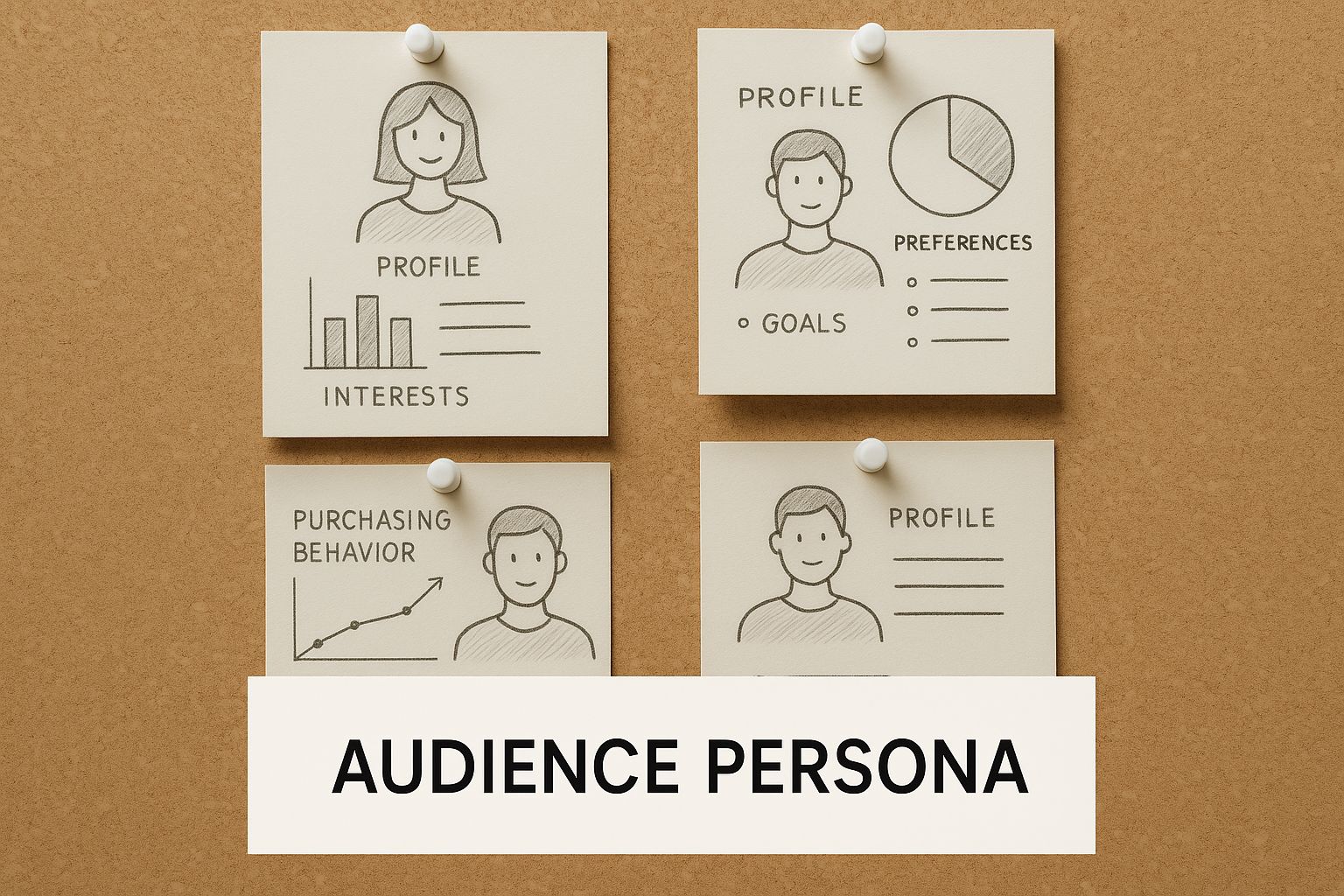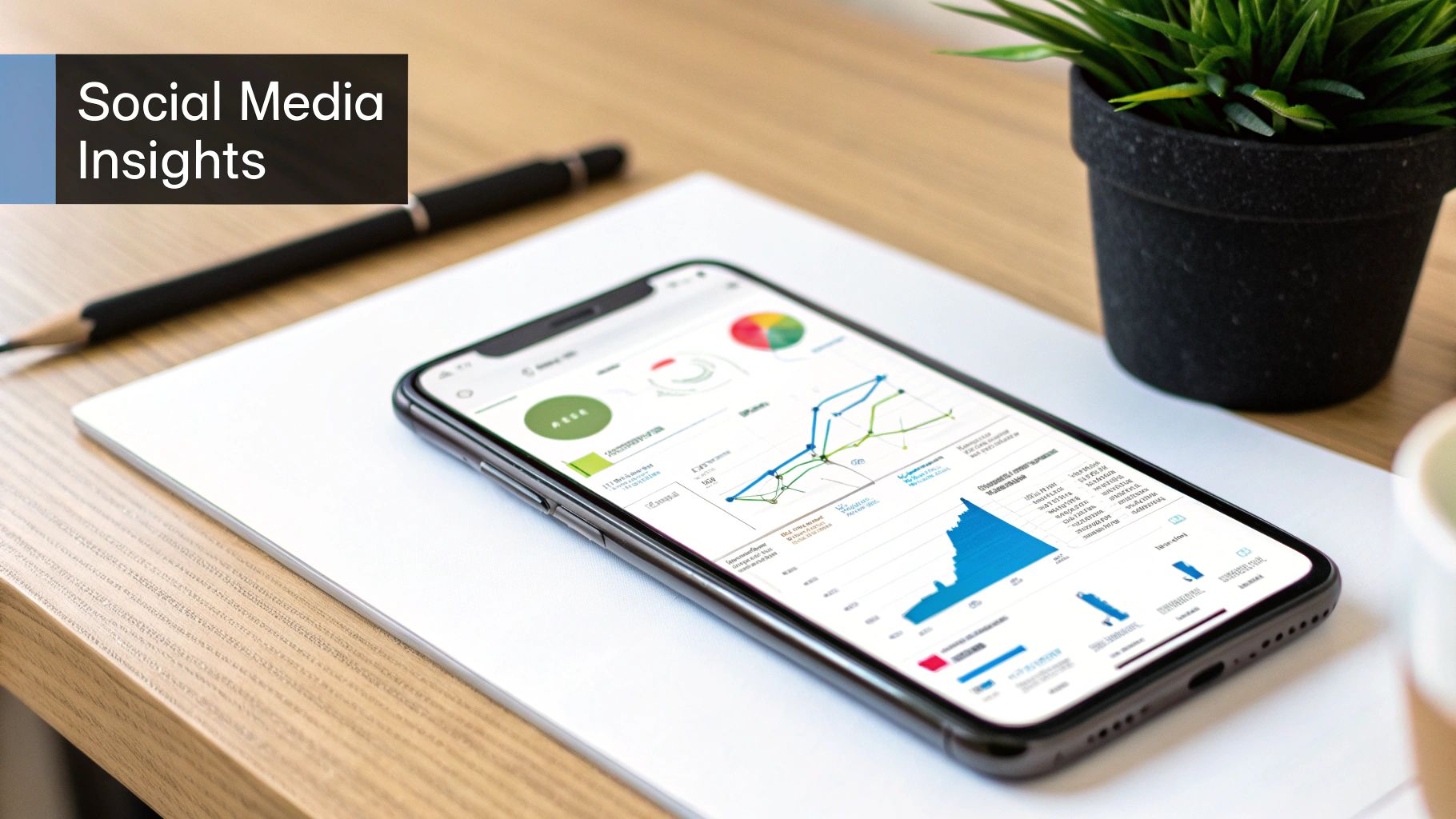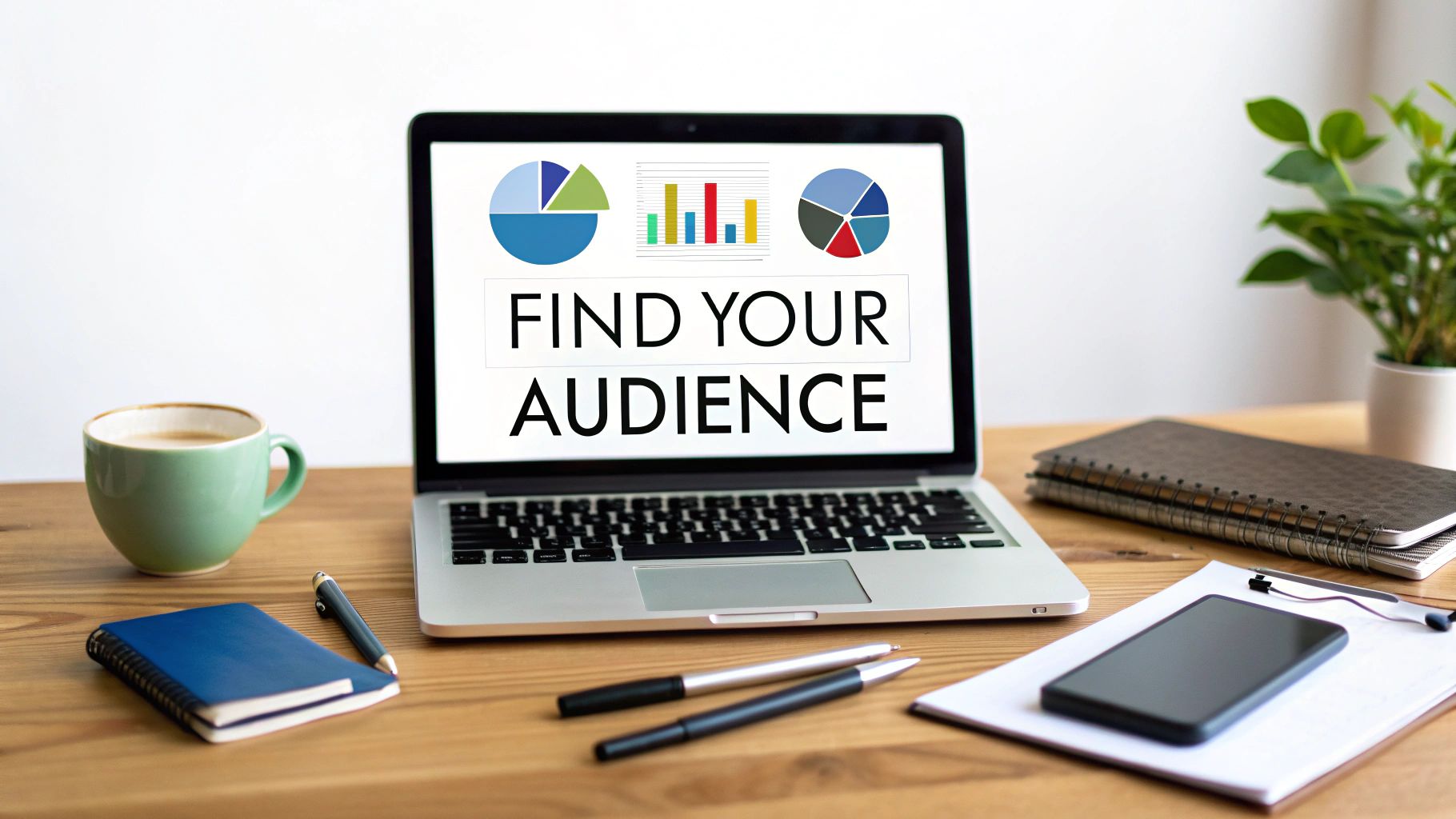If you try to sell to everyone, you'll end up selling to no one. It's a classic business mistake, but one I see all the time. Before we get into the nuts and bolts of how to find your people, we need to be crystal clear on why this laser focus is absolutely essential for your brand to survive, let alone thrive.
The Cost of Casting a Wide Net
Broad, generic marketing is like shouting into a hurricane. You’ll spend a lot of money, make a lot of noise, and no one will hear you. This one-size-fits-all approach just doesn't work anymore because it ignores the one thing modern customers demand: personal relevance. People expect you to get them—to understand their specific struggles and talk to them in their own language.
When you don't define a specific audience, you’re basically setting yourself up for failure. Here’s what happens:
- You burn through your budget. Your marketing dollars get spread thin across channels and groups of people who couldn’t care less about what you’re selling. Your ROI? Gone.
- Your brand gets muddled. Without a clear person to talk to, your brand's personality, values, and even its look become a confusing mess.
- Nobody cares. Generic content is boring. It doesn't get clicks, shares, or sales, and it certainly doesn't build a loyal following.
Finding Your Power in a Niche
Let’s make this real. Imagine a company selling high-end, ergonomic office chairs. If their marketing targets "everyone with an office job," their message is just noise. It's too broad.
But what if they zero in on "remote tech workers with chronic back pain"? Suddenly, everything changes. They can create articles and videos that speak directly to the frustrations of working from a poorly set up home office. They can run ads on platforms where developers and programmers hang out. They can build a whole community around solving that one, specific, nagging problem.
This is where sharp branding and market research come together to drive actual growth. Defining your audience isn't just a box to check on your marketing to-do list; it's the foundation of your entire business strategy.
The hard truth is your potential customers are not one big, happy family. They’re scattered across dozens of digital platforms and online communities, each with its own culture, rules, and expectations.
The numbers back this up. As of February 2025, the world had 5.56 billion internet users, but they aren't all in the same place or behaving the same way. For example, 93% of people in high-income countries use the internet, but that number plummets to just 27% in low-income nations, according to data you can explore on Statista.com.
This isn't just a random statistic. It's proof that you can't just throw a message out there and hope for the best. You have to get specific about geography, income, and behavior to have any chance of connecting.
Start With The Customers You Already Have

Before you go hunting for new customers, the best place to start is right in your own backyard. Your existing customer base is a goldmine. Seriously. These people have already given you the most honest feedback possible—their money.
Think of it as reverse-engineering your own success. Instead of guessing who might want your product, you can look at the real people who already love it.
Start by pulling up your sales data or firing up your CRM. You're not just looking for a list of everyone who's ever bought from you. You’re looking for your best customers. These are the folks who keep coming back, spend the most, and leave rave reviews without you even asking. They are the living, breathing proof of your ideal audience.
Find Patterns in Your Best Customers
Once you have a solid list—maybe your top 20, 50, or 100 clients—it’s time to put on your detective hat. Your mission is to find the common threads that tie them all together. We want to move from a fuzzy idea to a sharp, focused picture.
Start asking some specific questions about this group:
- Who are they, really? Look for patterns in their age, location, job titles, or even the industry they work in. A B2B software company might find its champions aren't Fortune 500 giants but scrappy, mid-sized marketing agencies.
- How did they find you? Did a particular social media channel send them your way? A specific Google search? Maybe they were referred by a friend. This tells you exactly where your ideal audience is hanging out.
- What did they actually buy? You'll often discover that your best customers flock to one or two specific products or services. This is a huge clue about what you do best.
This isn't about theory anymore. You're now working with cold, hard facts from people who have already proven they value what you do. It's probably the most overlooked—and most powerful—research you can do.
Your most loyal customers didn't just buy a product; they hired you to solve a specific problem. Your job is to figure out exactly what that problem was.
Build Your First Mini-Personas
Okay, now let's pull all these insights together into a few "mini-personas." Don't worry, these aren't the detailed, multi-page documents you might build later. Think of them as quick, fact-based sketches of your ideal customer.
For example, a boutique branding agency like Softriver might look at their best clients and spot a clear pattern. They could create a mini-persona like: "Startup founders, aged 30-45, in tech or e-commerce, who need a complete brand identity, fast, to lock down their first round of funding."
See how useful that is? It’s not a guess; it's based on real business. It tells the agency exactly who to talk to and what message will resonate: speed, quality, and making a killer impression on investors. With this proven model in hand, every other piece of your audience research becomes smarter and more effective. You now know exactly who you're looking for out in the wild.
Find Audience Insights On Social Media
Your ideal customers are already online, having conversations every single day. Social media is ground zero for these discussions. To truly understand your target audience, you have to move beyond vanity metrics like likes and followers. Think of platforms like Instagram, Facebook, and TikTok as massive, living focus groups you can tap into anytime.
These platforms are overflowing with real-time, unfiltered data. You can see exactly what people care about, the slang and phrases they use, and the problems they're actively trying to solve. When you dive into this information, you stop guessing who your audience is and start knowing them.
Dig Into Platform Analytics
The best place to start is with the tools you probably already have. If you’ve set up a business profile on any major social platform, you’ve got access to a pretty powerful analytics dashboard.
- Meta Business Suite (for Facebook & Instagram): This is your command center for seeing who follows you and how they interact with your content. Check out the "Audience" tab. It gives you a detailed breakdown of your followers' age, gender, and top locations. Are the people engaging with you the ones you expected?
- TikTok Analytics: Don't sleep on TikTok. Its analytics offer more than just follower counts. You can see growth trends, where your followers are located, and—this is the good part—what other videos and sounds they're engaging with. This is a direct window into their wider interests beyond your brand.
This is your first pass at finding your audience on social media. You’re using your own data to either confirm your initial assumptions or, more often than not, challenge them with cold, hard facts.
Uncover Clues in Your Competitors' Comments
Analyzing your own followers is only half the battle. The other, arguably more important, half is figuring out who’s talking to your competitors. Head over to their profiles and spend some serious time reading the comments on their posts.
This is where you'll strike gold. Are people asking highly technical questions? Are they begging for a new feature? Or are they complaining about a specific, recurring problem? These comments represent a direct line to the market's biggest unmet needs and frustrations.
The comment section is where you discover the real-world problems your audience faces. It’s not just feedback for your competitor; it's a list of opportunities for you.
This kind of manual research is priceless. It adds the "why" to the "what" you get from analytics dashboards and helps you understand the emotional triggers behind people's buying decisions. All of this information is crucial for building out detailed audience personas.
Once you have this data, visualizing it can make it much more tangible. It helps turn numbers and notes into a "person" your team can rally around.

Creating profiles like these transforms raw data into a relatable character who can guide your entire brand strategy, from messaging to product development.
Where Should You Focus Your Efforts?
Knowing which platform to focus on is key, because different people use different platforms for different reasons. A quick glance at the demographics can save you a ton of time and effort.
To help you decide where to start your research, here’s a quick breakdown of the major platforms:
Platform Audience At-a-Glance
This table gives you a starting point. For instance, the dominant age group on Facebook is 25-34 years old (31.1% of users), while Instagram’s core is slightly younger, with 18-24 year olds making up 31.7% of its audience. Interestingly, Facebook still leads for direct purchases, with 39% of users having bought something on the platform. You can discover more social media demographic insights on SproutSocial.com to really fine-tune your approach.
Ultimately, by understanding these nuances, you don’t just find your audience—you meet them where they're already active and receptive. This is how you effectively improve your brand awareness with top strategies and build a connection that lasts.
Use Competitor Analysis To Spot Opportunities
You don't have to figure out your audience in a vacuum. Your competitors, whether you love them or hate them, have already done some of the heavy lifting. By taking a close (and ethical) look at who they’re talking to, you can uncover some major opportunities and find the customers they’re completely ignoring.
The point here isn’t to just copy their strategy. It’s to get a real feel for the competitive landscape so you can position your brand in a way that’s both unique and valuable. Think of it as market research with a built-in cheat sheet.
Study Their Digital Footprint
Start by becoming a quiet observer. Pick your top three to five competitors and go exploring. First, visit their websites and really pay attention to the language they use. Who is their copy written for? Does it sound like they're talking to a budget-conscious beginner, or are they aiming for seasoned experts with money to spend?
Next, dive into their social media. Look past the vanity metrics like follower counts and see who is actually engaging with their stuff.
- Who comments on their posts? Click on the profiles of their most active followers. Are you seeing individuals, small businesses, or big corporate accounts?
- What questions are people asking? The comments section is a goldmine. If you see the same questions or complaints over and over, that's a sign of an unmet need you could solve.
- What kind of content gets the most love? Make a note of which posts get the most shares and comments. This tells you exactly what their audience finds valuable.
Let’s say a competitor posts advanced tutorials, but their comments are flooded with people asking basic, entry-level questions. That's a huge clue. It tells you there’s an underserved beginner audience just waiting for someone to help them.
By looking at what your competitors aren't doing, you can find your unique angle. The gaps in their strategy are the opportunities for yours.
Analyze Their Content and Messaging
Another great way to find your niche is to see where competitors are putting their content efforts. Platforms like YouTube are perfect for this. The global user base for YouTube is expected to reach 2.85 billion by 2025, with some very distinct clusters based on geography and interests. India, for example, leads with 491 million users—nearly double the audience in the US. You can see more YouTube user statistics on GlobalMediaInsight.com.
Understanding these regional differences can reveal massive, untapped markets. If all your competitors are making video content for an American audience, you might find a huge opportunity creating content tailored to an emerging market in their own language and cultural context.
Finally, spend some time digging through their customer reviews on sites like G2, Capterra, or even just on Google. Notice what customers love and what they complain about. The praise tells you what the market values, and the criticism is basically a to-do list for how you can build something better. This is how you find your unique selling proposition and carve out a space where you can genuinely win.
Build Customer Personas That Guide Your Strategy

Okay, so you've done the heavy lifting. You've dug into your customer data and peeked at what the competition is up to. Right now, though, all you have is a pile of raw data. It's insightful, sure, but it's not something your team can actually use.
The next step is to transform that data into a story. We need to give your ideal customer a name, a face, and a personality that feels real. This is where creating customer personas comes into play.
A persona is essentially a semi-fictional character who embodies your ideal customer. Think of it less as a dry report and more as a living, breathing guide that helps steer every decision you make—from product features to the tone of your next email.
There’s a world of difference between a weak, useless persona like "Millennial Marketer" and a strong, actionable one like "Sarah, the Overwhelmed Startup Founder." One is a vague label; the other is a person with real problems you can solve.
Go Beyond Basic Demographics
First things first, let's take all that quantitative data you gathered and start connecting the dots. Don't just list the facts; figure out what they mean.
- Demographics: This is your foundation. What's their age, where do they live, what’s their job title, and what’s their income bracket? This paints the basic picture.
- Psychographics: Now for the personality. What do they value? What are their interests and lifestyle choices? Are they driven by convenience, sustainability, or cutting-edge tech?
- Online Behavior: Where do they spend their time online? Are they scrolling Instagram for ideas, devouring industry blogs, or swapping tips in niche Facebook groups?
This first layer gives you a skeleton. For example, your data might point to "men, aged 25-40, living in urban areas, working in tech." It's a start, but it’s not a person yet.
Uncover Goals and Frustrations
Here’s where we give the persona a pulse. What gets this person out of bed in the morning? And what's keeping them up at night? This is how you find the direct line between their real-world problems and your solution. A crucial part of this process is clearly defining your Ideal Customer Profile (ICP).
Answering these questions turns a flat character into a three-dimensional person your team can truly understand and design for.
- What are their primary goals? What are they trying to accomplish, either personally or professionally? Maybe it's "Secure funding for their startup."
- What are their biggest pain points? What roadblocks are getting in their way? For instance, "Lacks a professional brand identity to impress investors."
- How can you help them? This is where you position your brand as the answer. For example, "We deliver a complete, investor-ready brand package in days."
A great persona doesn't just describe who your customer is; it explains why they need you. It’s the bridge between their problem and your solution.
Give Your Persona a Name and a Story
Finally, it's time to bring it all together into a simple, compelling narrative. Give your persona a name, find a stock photo that fits, and write a quick bio. To really flesh out the details, it helps to ask structured questions. We've got some great examples in our guide on top brand questionnaire templates that can help you dig deeper.
Let's imagine we’re a fast-turnaround branding agency and build a persona together.
Persona Name: Alex, The Ambitious Founder
Bio: Alex (32) is a first-time SaaS founder based in Austin, Texas. He just closed his pre-seed funding and is on a tight three-month runway to build an MVP and prove traction. He's a product genius but feels completely out of his depth with branding and marketing.
- Goals: Launch his app, onboard his first 1,000 users, and look sharp for his upcoming seed round with VCs.
- Frustrations: He’s completely overwhelmed, juggling a dozen different roles. He knows a polished logo and website are non-negotiable but assumes it will cost a fortune and take months—resources he simply doesn't have.
- Our Solution: We step in and give Alex a full brand identity package—logo, style guide, social media assets, the works—in under a week. He gets a premium, professional look without the traditional agency price tag or timeline.
See how that works? "Alex" is now a practical tool. Before writing a blog post, your team can ask, "Would this actually help Alex?" When thinking about a new service, they can ask, "Does this solve a real problem for him?" This is how you build a brand that people feel is built just for them.
Common Questions About Finding Your Audience
As you start digging into who your customers really are, a few questions almost always pop up. Let's walk through some of the most common ones I hear from brands trying to get this right.
What If I Have More Than One Audience?
This is a good sign! It means your product has broad appeal. The trick, though, is to resist the urge to lump everyone together into one generic customer profile. If you try to speak to everyone, you'll end up connecting with no one.
Instead, think in terms of primary and secondary audiences. Your primary audience is your bread and butter—the group that’s most profitable, most engaged, or most aligned with your long-term vision. They get the lion's share of your marketing budget and your main messaging.
For example, a high-end kitchenware brand might identify its primary audience as "home chefs who invest in premium tools for gourmet cooking."
Then, you can have secondary audiences you target with specific, smaller campaigns. That same kitchenware brand might have a secondary audience like "newlyweds creating their wedding registry." Each group needs a slightly different approach, different content, and maybe even different marketing channels. It's all about strategic prioritization.
How Often Should I Revisit My Audience Research?
Think of your audience research as a living document, not a "set it and forget it" task. Markets evolve, trends shift, and people’s needs change. What worked last year might fall flat today.
As a rule of thumb, plan a deep dive into your customer personas at least once a year. This is where you pull everything apart and make sure your core assumptions still hold true.
But you should be paying attention much more frequently.
- Quarterly Check-ins: Take a quick look at your analytics, read through social media comments, and scan customer feedback. Are there any new patterns or shifts in conversation?
- After Major Events: A new product launch, a rebrand, or a big move from a competitor should always trigger a review. You need to make sure your messaging is still hitting the mark in the new context.
The goal is to keep your finger on the pulse of your audience. Stale data leads to stale marketing that no longer connects with the people you’re trying to serve.
Can My Target Audience Be Too Niche?
It's possible, but honestly, it's rare. The much more common mistake is going way too broad. A niche only becomes "too small" if there genuinely aren't enough people in it to sustain your business. For most brands, a tight niche is a massive competitive advantage.
Before you go all-in on a super-specific group, do a quick reality check. Use free tools like Google Trends or the audience estimators in Meta or Google's ad platforms. You're just looking for a rough sense of market size. Does a sizable community for this interest actually exist?
Remember, an enthusiastic audience of 10,000 people who feel like you get them is infinitely more valuable than a disconnected audience of millions. The magic happens where specificity meets commercial viability.
What's the Real Difference Between a Target Market and a Target Audience?
People often use these terms as if they're the same thing, but the distinction is really important for creating marketing that actually works.
A target market is the broad group of people you're aiming to sell to.
- Example: "Millennial dog owners in North America."
A target audience is the specific slice of that market you’re trying to reach with your marketing message.
- Example: "First-time dog owners aged 25-35 living in urban apartments who shop at boutique pet stores and are concerned about all-natural ingredients."
Here’s a simple way to think about it: your market is the entire pond. Your audience is the specific fish you’re trying to catch with a very specific lure. Getting your audience right is what allows you to craft messages that feel personal and compelling.
Ready to build a brand identity that speaks directly to your ideal customer? Softriver specializes in creating custom logos and brand systems that connect with your target audience from day one. Our streamlined process delivers professional, market-aligned designs that set you up for success. Learn more about our branding packages.







